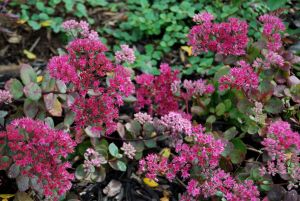So this morning I was planning to write a brief little post on Sedum ‘Vera Jameson’, when, what do I find? The taxonomists have gone and changed the name on me. How do you like that? We are now supposed to call this sedum Hylotelephium ‘Vera Jameson’. Go figure. Is this a meaningful name to you? The prefix “hylo-” is from the Greek word meaning “wood” or “matter”. And “telephium”? Well, according to legend, Telephus, the son of Hercules, discovered that boiling the leaves of Orpine (Sedum telephium) in milk, and drinking the resulting decoction, controlled diarrhea. This is hardly a descriptive improvement.
If you’re wondering what a taxonomist is, a taxonomist is an individual who classifies plants. You could say that taxonomists are to botany what archivists are to library science: they are determined to place plants into the correct pigeonhole of similar characteristics. Regrettably, the taxonomists, bless their hearts, don’t have a marketing bone in their bodies. Does anyone remember the fiasco with Clematis paniculata (Sweet Autumn Clematis)? One day, a few years back, the taxonomists decided to re-name this magnificent and popular plant Clematis maximowcziana. Come again? Talk about a commercial disaster for all those nurseries trying to correctly identify their stock of plants by scientific name. I was a Master Gardener then, and I remember how difficult it was, even for us, to remember that particular scientific name in order to help clients find the plant in commerce. Eventually, the taxonomists backed down, deciding to re-classify the plant one more time, and they called it Clematis terniflora. Okay, so that was better, but still not very memorable. Today, if you want to buy Sweet Autumn Clematis, just type into the search box on your browser “Clematis paniculata” and you’ll find that the nurseries have quietly rebelled against the taxonomists, once again using the comfortable, familiar name we all know.
I admit to being one of those Save Pluto types. (You recall how, in 2006, the head of the International Astronomical Union rammed through a new definition of “planet”, deciding that Pluto no longer qualified as anything but a “dwarf planet”?) So I’m going to be cantankerous, and continue to refer to Sedum ‘Vera Jameson’ by what I consider its rightful name. This charming little plant is a member of the family Crassulaceae–basically a family of succulents. The leaves are plump, fleshy and ovate. Throughout the growing season, the leaves are gray-green in color; but, come fall, they take on shades of dusty pink. The flowers, which appear in late summer to early fall, range from brilliant pink to dusty pink to reddish-pink, changing as the weeks progress. ‘Vera Jameson’s habit can become lax and open over time (perhaps that’s a clue to divide plants the following spring), but, since it’s a short plant, its floppiness isn’t really objectionable.
Normally, I’m not a big fan of succulents, since I find their unusual structure a bit difficult to integrate into the garden. However, sedums have one great attribute: they are tough. They laugh in the face of clay soil, cold weather, and mounds of road salt (also making them a valuable plant for those whose gardens are near the seashore). They have no pest or disease problems and don’t require much moisture once established. If you decide to try Sedum ‘Vera Jameson’, I recommend planting it in groups or as an edging plant, where its values can be appreciated best.

